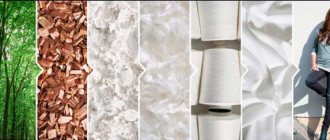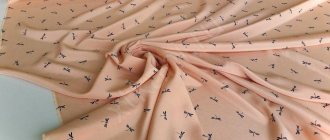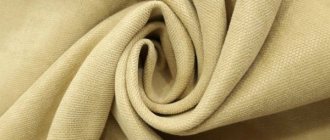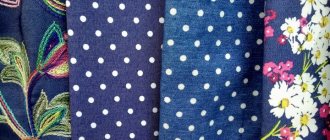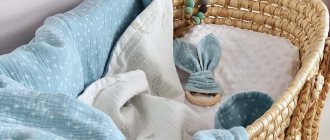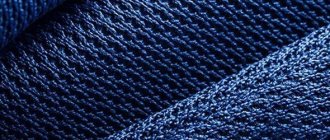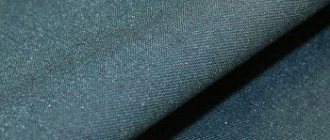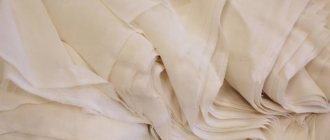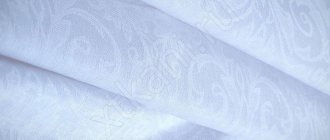Home / Artificial fabrics
Back
Published: 12/05/2020
Reading time: 3 min
1
135
Triacetate fabric occupies a special place among artificial materials. In terms of tactile sensations and decorative properties, it is in no way inferior to natural silk, and in terms of performance it surpasses other textiles in its class. Plus, natural resources are not destroyed during production, which means there is no damage to the environment.
- 1 Appearance and characteristics
- 2 Manufacturing and composition
- 3 Benefits
- 4 Disadvantages
- 5 Use
- 6 Care
- 7 Conclusion
What type of fabric is this
Triacetate fabric is a type of acetate silk. This is an artificial (not synthetic!) material obtained from solutions of triacetylcellulose in a mixture of methylene chloride and alcohol. The raw materials for its production are cotton or wood waste. Spinning of triacetate fiber is carried out using the dry method in machines that resemble in their design machines for spinning nylon fiber.
Triacetate colors
To obtain a thread, a solution of triacetylcellulose is pressed into a box - a device through which hot air is blown. During the blowing process, the solvents evaporate and the polymer fibers are sent to spinning machines. The result is a material with a smooth, shiny surface that is pleasant to the touch.
Catalog of fabrics made from artificial fibers
What is triacetate made of?
The method for obtaining fibers is reflected in the title. The material is obtained by acetylation of cellulose waste.
Triacetate
The method is convenient because it allows you to use any cellulose waste: cotton or pre-prepared wood pulp. The backbone of the polymer is linked glucose units in the β-form. In the molecules of monomeric residues, three groups remain free, which can be acetylated to form esters.
- With complete acetylation, triacetylcellulose is formed, which is usually called triacetate or primary acetate. The content of acetyl residues in the complete acylation product reaches 61.5%.
- Triacetate can be subjected to partial cleavage - saponification, in which a certain amount of acetic acid residues is released. The resulting product is called secondary cellulose acetate. In this case, the content of acid residues in the polymer molecule reaches 56% of the total mass.
Both compounds of acetylated cellulose are used to produce fibrous materials, varnishes, membranes, and films.
Modified polymer fibers are spun from a solution using a dry process. In this case, the solution is passed through the dies. The emerging jets are blown with hot air. The solvent evaporates and the polymer fiber hardens.
Origin story
Acetates were first made from cellulose in Great Britain during the First World War by the Dreyfus brothers, which produced non-flammable varnishes for aircraft. Then this company improved the technique and began to produce acetate in the form of shiny threads, very reminiscent of natural silk.
Acetate
Artificial fabric acetate: what is this material and what are its features?
more details
Silk
Fame and luxury: a detailed review of silk fabric
more details
In the USSR, the first plant for the production of acetate thread was built in the Moscow region, in Serpukhov in 1954. The material was in great demand, as it had a number of characteristics characteristic of natural silk, but stood out for its affordable price. With the advent of new synthetic fibers, the demand for it has dropped markedly.
Description
Cellulose triacetate is an ether of cellulose and acetic acid. It is an amorphous white substance in the form of flakes or powder.
Chemical formula of cellulose triacetate: [C6H7O2 (OCOCH3)3]n, where: n is the degree of polymerization. This value is in the range of 150-700. The average degree of polymerization is 260-300. The molecular weight of the compound is 25-115 thousand g/mol.
The structural formula of cellulose triacetate is shown in the figure below.
This compound is a thermoplastic, that is, it is capable of transforming into a highly elastic state when heated, but its thermal resistance is not high. At the softening temperature, the color of the material begins to change.
Fabric composition and its properties
Since triacetate is a type of artificial silk, it has all the properties inherent in this material:
- elasticity;
- shine;
- softness;
- low creasing;
- ability to transmit ultraviolet rays;
- low hygroscopicity;
- resistance to alkalis and acids;
- easy to wash;
- ability to become electrified;
- reduced thermal stability: already at a temperature of 170°C the fibers begin to deform.
Properties of triacetate fibers
The fibrous material, made from acetylated cellulose, looks like a ribbed circle in cross-section. The outer part has a smooth shiny appearance. Through dies with a figured profile, profiled threads are drawn, which slide less than conventional triacetate threads and have a lower surface gloss.
- The mechanical properties of triacetate fibers are characterized by low strength, which decreases by 60% when wet. The material has low abrasion resistance, average elasticity, and a high tendency to elongate (up to 30% dry).
- Physical properties are characterized by low hygroscopicity, high heat and light resistance.
- Chemically, the fibers are resistant to many reagents, except acetone. They stain well and are impervious to the action of microorganisms.
Fabrics that enjoy stable popularity are made from fibrous raw materials with the combination of these qualities.
Types of fabric
Triacetate itself is a type of acetate silk, so it differs only in color: it can be plain-dyed or printed. At first, fabric production was complicated by the lack of suitable dyes. But then, with the advent of special dyes, the textile industry began to produce a great variety of colors of this material.
Triacetate is often used as an additive to other fabrics: wool, cotton, knitwear. This additive improves the properties of fabrics: it prevents the appearance of pilling on products and reduces the wrinkling of fabrics.
Physicochemical characteristics
Cellulose triacetate, the formula of which contains 3 acetyl groups COCH3, has the following main characteristics:
- highly soluble in substances such as: glacial acetic acid, chloroform, aniline, pyridine, phenol, formic acid, formamide, liquid sulfur dioxide, methylene chloride (the most common solvent at present);
- easily crystallizes when heated to a temperature of 210-225°C;
- insoluble in water, esters, acetone and ethyl acetate;
- low hygroscopicity;
- density 1280–1330 kg/m3;
- in solutions of acids and alkalis, saponification of the substance occurs, that is, it is unstable;
- good light resistance;
- high fiber and film-forming properties;
- softening temperature – 190-210 °C, decomposition (destructuring) – 230 °C;
- ignition temperature – 295 °C, self-ignition temperature – 380-430 °C.
The thermal stability of a substance is increased by adding stabilizers (antioxidants containing amino groups and other substances).
Advantages and disadvantages
Advantages of triacetate:
- silky, pleasant to the touch;
- retains its shape perfectly, especially when forming pleated folds;
- easy to care for: even difficult stains can be washed off easily;
- dries quickly, practically does not wrinkle;
- “uninteresting” for moths;
- looks like natural silk, but much cheaper.
There are also disadvantages:
- practically does not absorb moisture;
- low tensile strength of threads, especially when wet;
- not sufficiently resistant to abrasion, especially after frequent washing it loses its original appearance;
- afraid of high temperatures;
- Difficult to cut: slides and crumbles;
- electrified.
How to distinguish triacetate from natural silk
Acetate fabrics are often called rayon because of their great external similarity. You can distinguish them using simple techniques.
- When natural fibers are burned, the smell of burnt hair appears. Acetate silk melts without such a smell.
- Natural silk hardly wrinkles. On acetate fabrics, after creasing, traces of folds remain that do not align.
- Triacetate fabric remains cool when applied to the body; natural silk, due to its high thermal conductivity, quickly acquires body temperature.
Triacetate has special care properties and does not withstand very long use. The low cost and beautiful appearance compensate a hundredfold for the specific features of the fabric.
What standards are used in production?
All standards used in the manufacture of artificial fabrics, incl. and triacetate are prescribed in “GOST 23433-79 Fabrics and piece goods from chemical fibers”, namely:
- color fastness to light - OST 9733.1-91;
- color fastness to washing - according to GOST 9733.4-83;
- color fastness to ironing - according to GOST 9733.7-83;
- color fastness to friction - according to GOST 9733.27-83;
- air permeability - according to GOST 29298-2005;
- tensile tensile characteristics - according to GOST 3813-72.
How to care for triacetate products
The material does not require special washing techniques. It is important to remember the basic rules.
- It is better to wash products made from acetate fabrics in delicate modes of an automatic machine or by hand.
- For effective rinsing, you can use special additives.
- After washing, the products should be carefully hung, allowed to drain, and air dried without heating.
- If there is a need to iron the product, it is better to do it from the reverse side. For better ironing, this should be done through a thin, damp cloth made of natural material (cotton).
For what purposes can it be used?
Beautiful appearance plus low price made this material in demand in light industry.
From triacetate they sew:
Inexpensive and beautiful underwear
Home clothes: dressing gowns, pajamas, negligees
Light outerwear: dresses, blouses, skirts (especially pleated ones)
Lining for coats, suits and raincoats
Bed sheets
Curtains and drapes, especially with complex drapery
Application
Triacetate is one of the most popular materials. Designer clothes are made from it - lightweight and with unique external qualities. The material is distinguished by low thermal conductivity, which allows it to be used in the manufacture of linings for winter clothing (jackets, coats, etc.).
In addition, triacetate, like no other material, is suitable for making beautiful and elegant curtains of various shapes, colors and styles. It makes excellent draped curtains and porters.
At what approximate price does it sell?
You can buy triacetate in stores selling fabrics at a price of 200 to 500 rubles per 1 meter (the width of the material is usually 135-140 cm). On online platforms specializing in the sale of vintage products, you can buy cuts of triacetate silk produced in the USSR. But it’s already more expensive - up to 700 rubles per linear meter.
Triacetate is a material that undoubtedly has certain advantages: it is pleasant to the touch, lightweight, drapes well, and most importantly, it is very similar to natural silk. But at the same time inexpensive. Therefore, despite the emergence of new artificial fabrics, it will be in demand among consumers for a long time.
Flaws
Alas, triacetate also has weaknesses, which are explained by the artificial method of obtaining fibers and its physicochemical properties:
Author:
Anastasia Kukushkina
I hope you enjoy the article I have prepared for you! If you find errors in it, write to me about it! I will answer any questions you have, ask them!
